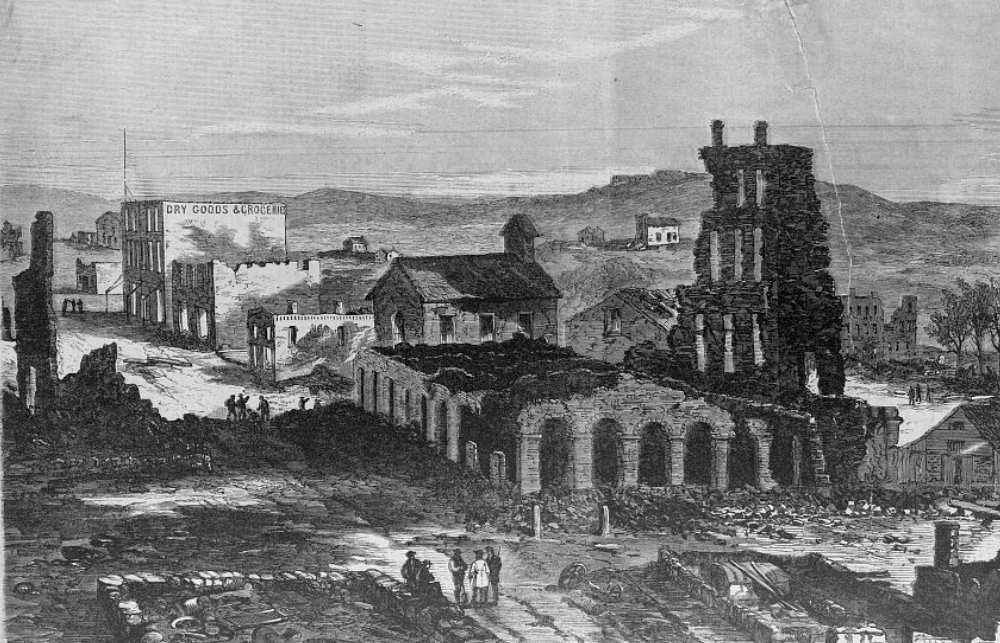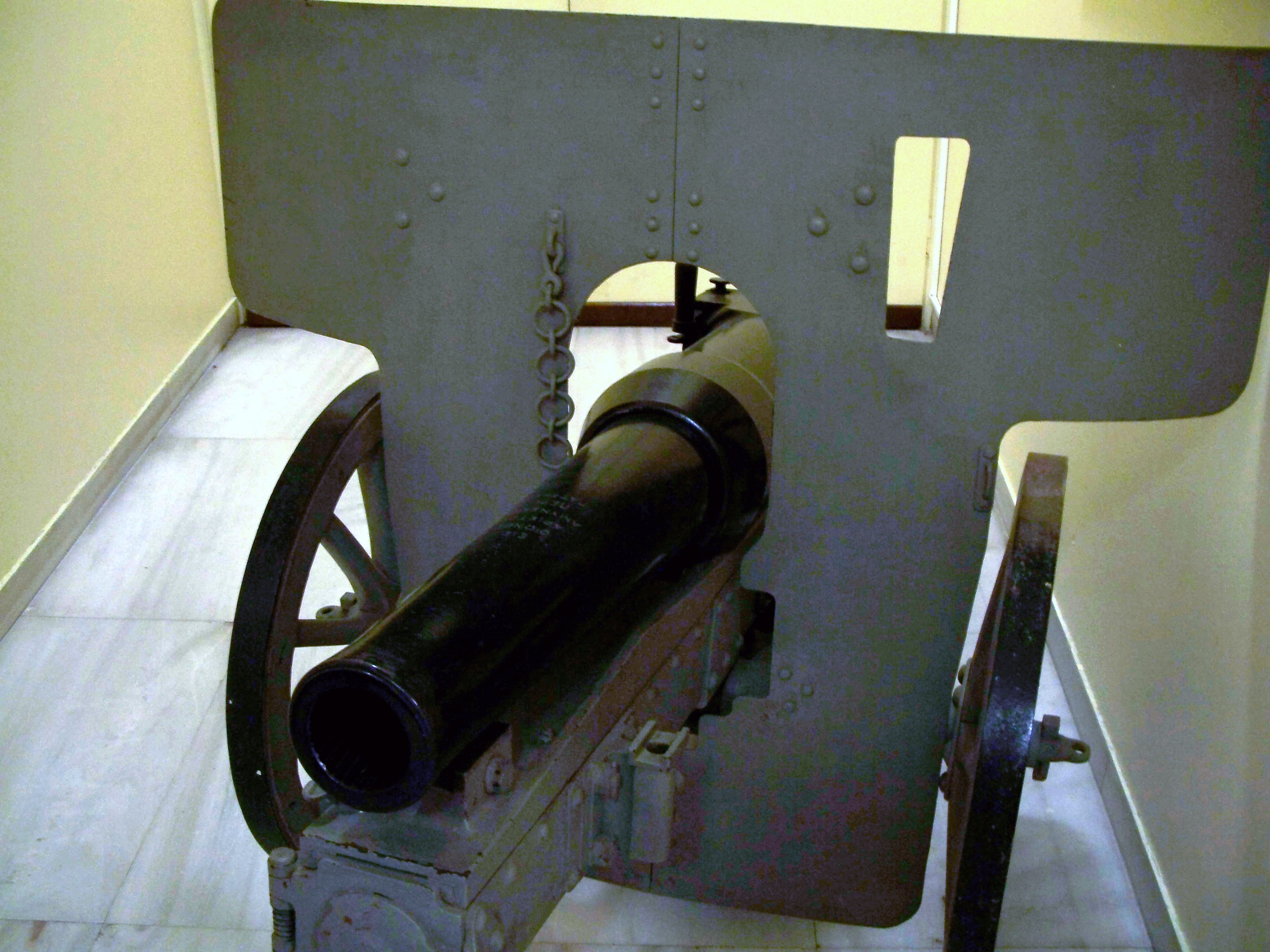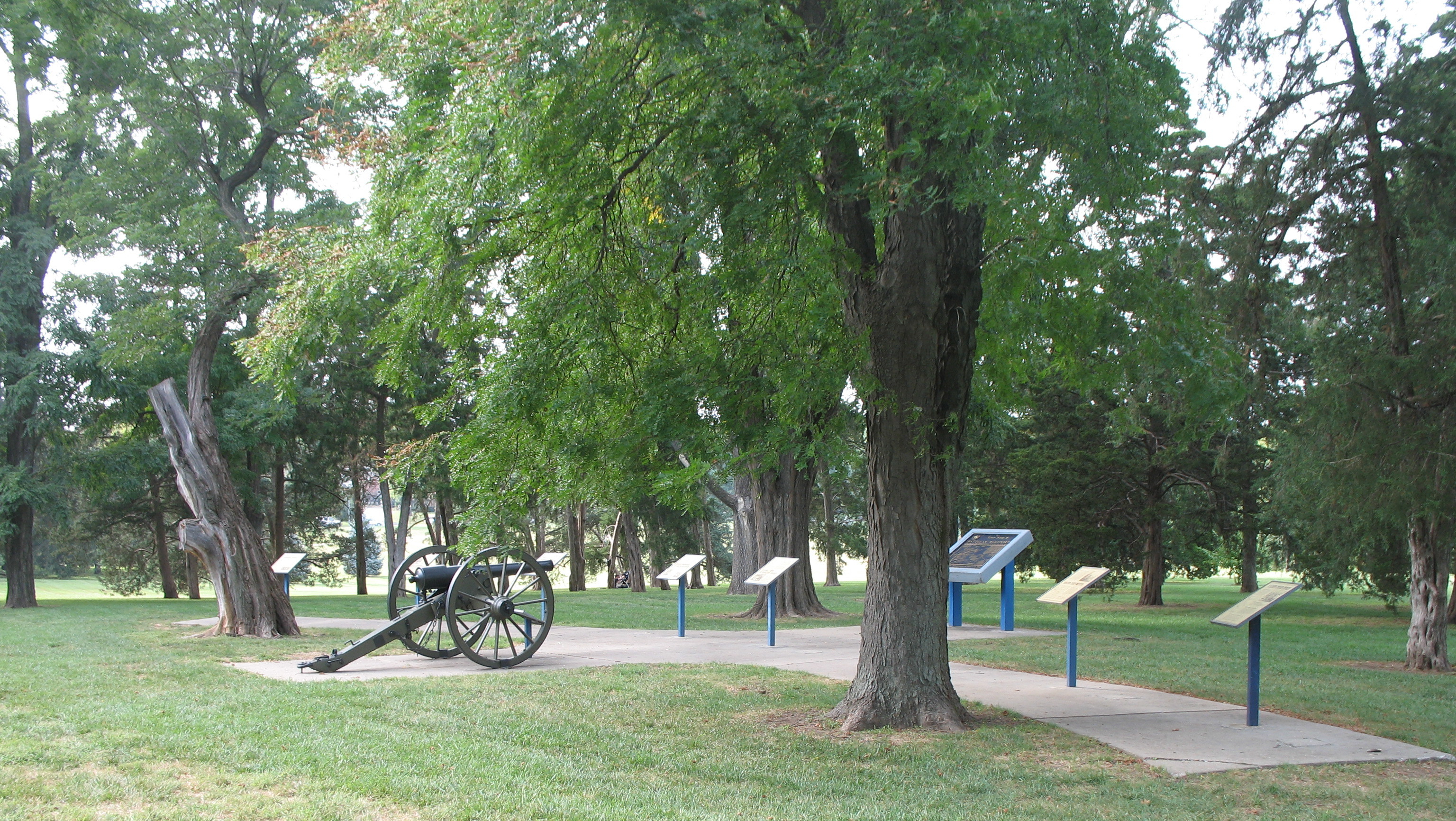|
Fort Simple
Fort Simple was an American fort built in Topeka, Kansas, as a result of Maj. Gen. Sterling Price's Missouri Raid in the late summer and fall of 1864 (see Price's Raid). Topeka had become the permanent capital of the State of Kansas in 1861, but no fortifications had been built to protect the city from guerrilla bands, which roamed eastern Kansas. Even the raid and massacre in August 1863 in Lawrence, Kansas (see Lawrence Massacre), did not result in a fort being built to protect the capital, although plans had been made to build one by July 1864. History On October 8, 1864, Gov. Thomas Carney called the state militia to defend Kansas against Price's Confederates. The 2nd Regiment, based in Shawnee County (where Topeka was located), was sent to western Missouri to meet Price's force. A group of 292 men were also organized into a home regiment to guard Topeka. The men possessed one cannon, probably a mountain howitzer (see Mountain gun). The home regiment, led by Maj. Andrew Sta ... [...More Info...] [...Related Items...] OR: [Wikipedia] [Google] [Baidu] |
Topeka, Kansas
Topeka ( ; Kansa language, Kansa: ; iow, Dópikˀe, script=Latn or ) is the Capital (political), capital city of the U.S. state of Kansas and the County seat, seat of Shawnee County, Kansas, Shawnee County. It is along the Kansas River in the central part of Shawnee County, in northeast Kansas, in the Central United States. As of the 2020 United States census, 2020 census, the population of the city was 126,587. The Topeka Topeka, Kansas metropolitan area, metropolitan statistical area, which includes Shawnee, Jackson County, Kansas, Jackson, Jefferson County, Kansas, Jefferson, Osage County, Kansas, Osage, and Wabaunsee County, Kansas, Wabaunsee Counties, had a population of 233,870 in the 2010 United States Census, 2010 census. The name "Topeka" is a Kansa-Osage word that means "place where we dig potatoes", or "a good place to dig potatoes". As a placename, Topeka was first recorded in 1826 as the Kansa name for what is now called the Kansas River. Topeka's founders chose ... [...More Info...] [...Related Items...] OR: [Wikipedia] [Google] [Baidu] |
Sterling Price
Major-General Sterling "Old Pap" Price (September 14, 1809 – September 29, 1867) was a senior officer of the Confederate States Army who commanded infantry in the Western and Trans-Mississippi theaters of the American Civil War. Prior to that, he served as the 11th governor of Missouri from 1853 to 1857. Major-General Sterling Price (September 14, 1809 – September 29, 1867) was a United States General and senior officer of the Confederate States Army who fought in both the Western and Trans-Mississippi theaters of the American Civil War. He rose to prominence during the Mexican–American War and served as governor of Missouri from 1853 to 1857. He is remembered today for his service in Arkansas (1862–1865) and for his defeat at the Battle of Westport on October 23, 1864. Early life and entrance into politics Virginia Sterling Price was born in Prince Edward County, Virginia, near Farmville, to a family of planters of Welsh origin. His parents, Pugh and Elizabe ... [...More Info...] [...Related Items...] OR: [Wikipedia] [Google] [Baidu] |
Price's Raid
Price's Missouri Expedition (August 29 – December 2, 1864), also known as Price's Raid or Price's Missouri Raid, was an unsuccessful Confederate cavalry raid through Arkansas, Missouri, and Kansas in the Trans-Mississippi Theater of the American Civil War. Led by Confederate Major-General Sterling Price, the campaign's intention was to recapture Missouri and renew the Confederate initiative in the larger conflict. Despite achieving several early victories, Price was ultimately defeated at the Battle of Westport by Union forces under Major-General Samuel R. Curtis in late October. He suffered further reverses at the hands of Union cavalry under Major-General Alfred Pleasonton at the Battle of Mine Creek, Kansas, forcing him to retreat back into Arkansas. Price's Missouri Expedition proved to be the last significant Southern operation west of the Mississippi River. Its failure bolstered confidence in an ultimate Union victory in the war, thereby contributing to President Abraha ... [...More Info...] [...Related Items...] OR: [Wikipedia] [Google] [Baidu] |
Kansas
Kansas () is a state in the Midwestern United States. Its capital is Topeka, and its largest city is Wichita. Kansas is a landlocked state bordered by Nebraska to the north; Missouri to the east; Oklahoma to the south; and Colorado to the west. Kansas is named after the Kansas River, which in turn was named after the Kansa Native Americans who lived along its banks. The tribe's name (natively ') is often said to mean "people of the (south) wind" although this was probably not the term's original meaning. For thousands of years, what is now Kansas was home to numerous and diverse Native American tribes. Tribes in the eastern part of the state generally lived in villages along the river valleys. Tribes in the western part of the state were semi-nomadic and hunted large herds of bison. The first Euro-American settlement in Kansas occurred in 1827 at Fort Leavenworth. The pace of settlement accelerated in the 1850s, in the midst of political wars over the slavery debate. Wh ... [...More Info...] [...Related Items...] OR: [Wikipedia] [Google] [Baidu] |
Lawrence, Kansas
Lawrence is the county seat of Douglas County, Kansas, Douglas County, Kansas, United States, and the sixth-largest city in the state. It is in the northeastern sector of the state, astride Interstate 70, between the Kansas River, Kansas and Wakarusa River, Wakarusa Rivers. As of the 2020 United States census, 2020 census, the population of the city was 94,934. Lawrence is a college town and the home to both the University of Kansas and Haskell Indian Nations University. Lawrence was founded by the New England Emigrant Aid Company (NEEAC) and was named for Amos A. Lawrence, an abolitionist from Massachusetts, who offered financial aid and support for the settlement. Lawrence was central to the "Bleeding Kansas" period (1854–1861), and the site of the Wakarusa War (1855) and the Sacking of Lawrence (1856). During the American Civil War it was also the site of the Lawrence massacre (1863). Lawrence began as a center of Free-Stater (Kansas), free-state politics. Its economy diver ... [...More Info...] [...Related Items...] OR: [Wikipedia] [Google] [Baidu] |
Lawrence Massacre
The Lawrence Massacre, also known as Quantrill's Raid, was an attack during the American Civil War (186165) by Quantrill's Raiders, a Confederate guerrilla group led by William Quantrill, on the Unionist town of Lawrence, Kansas, killing around 150 unarmed men and boys. The attack on the morning of Friday, August 21, 1863 targeted Lawrence due to the town's long support of abolition and its reputation as a center for the Jayhawkers, who were free-state militia and vigilante groups known for attacking plantations in pro-slavery Missouri's western counties. Background By 1863, Kansas had long been the center of strife and warfare over the admission of slave versus free states. In the summer of 1856, the first sacking of Lawrence sparked a guerrilla war in Kansas that lasted for years. John Brown might be the best known participant in the violence of the late 1850s participating on the abolitionist or Jayhawker side, but numerous groups fought for each side during the "Bleedi ... [...More Info...] [...Related Items...] OR: [Wikipedia] [Google] [Baidu] |
Thomas Carney
Thomas Carney (August 20, 1824 – July 28, 1888) was the second Governor of Kansas. Biography Carney was born in Delaware County, Ohio, to James and Jane (Ostrander) Carney. James died in 1828, leaving a widow and four young sons. Thomas remained at home farming with his mother until age 19. He was educated in Berkshire, Ohio, where he lived with an uncle. He worked in mercantile businesses and finally established a successful wholesale business in Leavenworth, Kansas. The year he was elected to the state legislature, he married Rebecca Ann Cannady. Career After his term as State Representative, Carney was elected Governor of Kansas and served from 1863 through 1865. During his tenure, he devoted his efforts to developing the state and addressing the issues caused by the Civil War. He was elected Mayor of Leavenworth in 1865. A founder of the First National Bank of Leavenworth, he also served as Director of the Lawrence and Fort Gibson Railroad Company. Carney was co ... [...More Info...] [...Related Items...] OR: [Wikipedia] [Google] [Baidu] |
Shawnee County
Shawnee County (county code SN) is located in northeast Kansas, in the central United States. As of the 2020 census, the population was 178,909, making it the third-most populous county in Kansas. Its most populous city, Topeka, is the state capital and county seat. The county was one of the original 33 counties created by the first territorial legislature in 1855, and it was named for the Shawnee tribe of Native Americans. History Early history For many millennia, the Great Plains of North America was inhabited by nomadic Native Americans. From the 16th century to 18th century, the Kingdom of France claimed ownership of large parts of North America. In 1762, after the French and Indian War, France secretly ceded New France to Spain, per the Treaty of Fontainebleau. 19th century In 1802, Spain returned most of the land to France, but keeping title to about 7,500 square miles. In 1803, most of the land for modern day Kansas was acquired by the United States from France ... [...More Info...] [...Related Items...] OR: [Wikipedia] [Google] [Baidu] |
Missouri
Missouri is a U.S. state, state in the Midwestern United States, Midwestern region of the United States. Ranking List of U.S. states and territories by area, 21st in land area, it is bordered by eight states (tied for the most with Tennessee): Iowa to the north, Illinois, Kentucky and Tennessee to the east, Arkansas to the south and Oklahoma, Kansas and Nebraska to the west. In the south are the Ozarks, a forested highland, providing timber, minerals, and recreation. The Missouri River, after which the state is named, flows through the center into the Mississippi River, which makes up the eastern border. With more than six million residents, it is the List of U.S. states and territories by population, 19th-most populous state of the country. The largest urban areas are St. Louis, Kansas City, Missouri, Kansas City, Springfield, Missouri, Springfield and Columbia, Missouri, Columbia; the Capital city, capital is Jefferson City, Missouri, Jefferson City. Humans have inhabited w ... [...More Info...] [...Related Items...] OR: [Wikipedia] [Google] [Baidu] |
Mountain Gun
Mountain guns are artillery pieces designed for use in mountain warfare and areas where usual wheeled transport is not possible. They are generally capable of being taken apart to make smaller loads for transport by horses, humans, mules, tractors, or trucks. As such, they are sometimes called "pack guns" or "pack howitzers". During the American Civil War these small portable guns were widely used and were called "mountain howitzers". The first designs of modern breechloading mountain guns with recoil control and the capacity to be easily broken down and reassembled into highly efficient units were made by Greek army engineers P. Lykoudis and Panagiotis Danglis (after whom the Schneider-Danglis gun was named) in the 1890s. Mountain guns are similar to infantry support guns. They are largely outdated, their role being filled by howitzers, mortars, multiple rocket launchers, recoilless rifles and missiles. Most modern artillery is manufactured from light-weight materials and can ... [...More Info...] [...Related Items...] OR: [Wikipedia] [Google] [Baidu] |
American Civil War
The American Civil War (April 12, 1861 – May 26, 1865; also known by other names) was a civil war in the United States. It was fought between the Union ("the North") and the Confederacy ("the South"), the latter formed by states that had seceded. The central cause of the war was the dispute over whether slavery would be permitted to expand into the western territories, leading to more slave states, or be prevented from doing so, which was widely believed would place slavery on a course of ultimate extinction. Decades of political controversy over slavery were brought to a head by the victory in the 1860 U.S. presidential election of Abraham Lincoln, who opposed slavery's expansion into the west. An initial seven southern slave states responded to Lincoln's victory by seceding from the United States and, in 1861, forming the Confederacy. The Confederacy seized U.S. forts and other federal assets within their borders. Led by Confederate President Jefferson Davis, ... [...More Info...] [...Related Items...] OR: [Wikipedia] [Google] [Baidu] |
Battle Of Westport
The Battle of Westport, sometimes referred to as the "Gettysburg of the West", was fought on October 23, 1864, in modern Kansas City, Missouri, during the American Civil War. Union Army, Union forces under Major General (United States), Major General Samuel R. Curtis decisively defeated an outnumbered Confederate States Army, Confederate force under Major General Sterling Price. This engagement was the turning point of Price's Missouri Expedition, forcing his army to retreat. The battle ended the last major Confederate offensive west of the Mississippi River, and for the remainder of the war the United States Army maintained solid control over most of Missouri. This battle was one of the largest to be fought west of the Mississippi River, with over 30,000 men engaged. Westport Westport, Kansas City, Westport (now a part of Kansas City, Missouri) had already established its place in history by the time Union and Confederate forces clashed there in 1864. John Calvin McCoy, kno ... [...More Info...] [...Related Items...] OR: [Wikipedia] [Google] [Baidu] |
.jpg)





